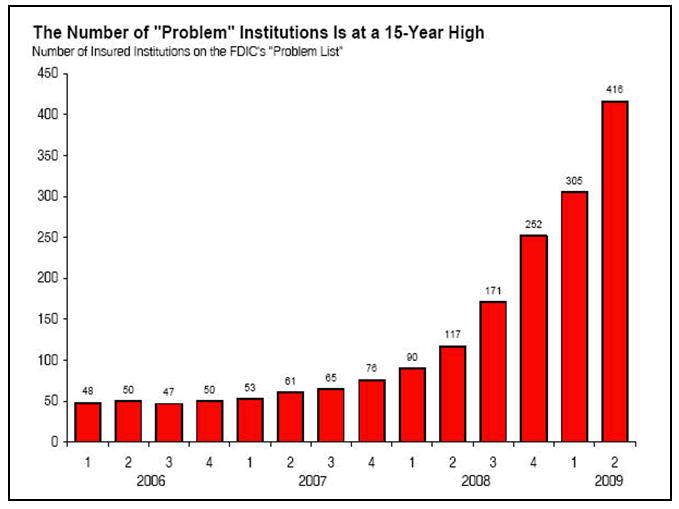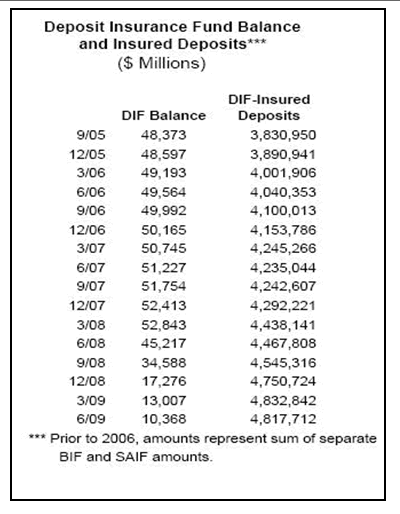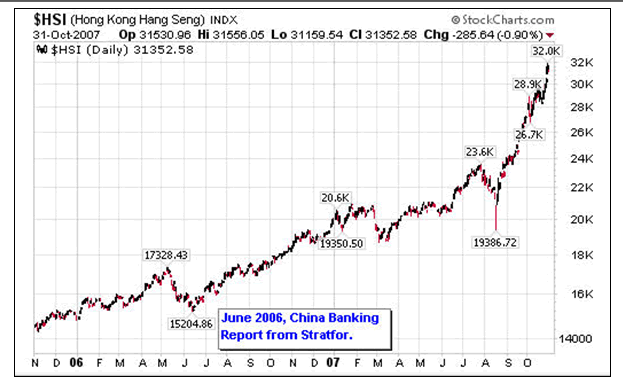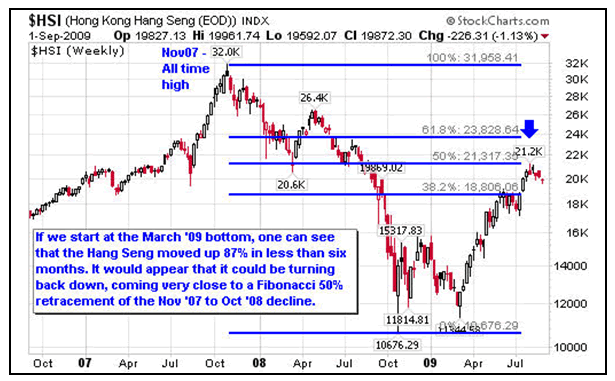Banking Crisis Accelerates as Number of Problem Institutions Grows
Stock-Markets / Credit Crisis 2009 Sep 02, 2009 - 02:23 PM GMTBy: Doug_Wakefield
 “‘The Nation was rich, Trade prodigiously great, Paper-Credit run high, and the Goldsmiths in Lombard-street, &c, commanded immense sums…’ was how Daniel Defoe remembered the 1680s.” – Devil Take the Hindmost: A History of Financial Speculation
“‘The Nation was rich, Trade prodigiously great, Paper-Credit run high, and the Goldsmiths in Lombard-street, &c, commanded immense sums…’ was how Daniel Defoe remembered the 1680s.” – Devil Take the Hindmost: A History of Financial Speculation
September 2009. As I start another month of life, after 5 years of researching and writing about markets and crowds, I wonder how many individuals have learned anything from this significant period of history. Do they use the same strategies they did in the fall of 2004? Do they still believe they have the right to a stock market that provides their “god-given” personal retirement goals, no matter how corrupt their political and financial leaders become? When the FDIC reports that “During the [2nd] quarter, the number of institutions on the FDIC’s ‘Problem List’ increased from 305 to 416, and the combined assets of ‘problem’ institutions rose from $220 to $299.8 billion,” representing the “largest number of ‘problem’ institutions since June 30, 1994,” how are we to get a better perspective of the severity of our banks’ troubles?

(Chart from Q2 ’09 FDIC Quarterly Banking Profile)
Better yet, how is it that investment companies and advisors are told they must disclose all risks to the public, while the most powerful force in our nation’s monetary structure continues the fight so that it will NOT have to disclose its dealings with the most dominant players in our financial system?
The Federal Reserve must for the first time identify the companies in its emergency lending programs after losing a Freedom of Information Act lawsuit… The Fed has refused to name the financial firms it lent to or disclose the amounts or the assets put up as collateral under 11 programs.
Now, why would the Fed want to be opaque about the billions in loans it made to certain financial players? Their simple answer: saying where the money went and on what terms might “set off a run by depositors and unsettle shareholders.”
Hmm. The chart below can be found on page nineteen of the FDIC’s Q2 Quarterly Banking Profile. Should the gap and trend between deposits and insurance funds be a tad bit disturbing to American bank depositors?

If the number of problem banks rises, while the amount of money in the Deposit Insurance Fund is depleted by 80 percent in a little over a year, how is it that we speak of bank deposits as “low risk” or “risk free” investments?
As we sip our morning coffee and read the Wall Street Journal at the start of this September, we note an article, Raft of Deals for Failed Banks Puts U.S. on Hook for Billions. And, since the same article is included in the Tehran Times, we can be sure that the rest of the world is watching this too.
To encourage banks to pick through the wreckage of their collapsed competitors, the Federal Deposit Insurance Corp. has agreed to assume most of the risk on $80 billion in loans and assets. The agency expects it will eventually have to cover $14 billion in losses on deals cut so far. The initiative amounts to a subsidy for dozens of handpicked banks… The agency’s total exposure is about six times the amount remaining in its fund that guarantees consumers’ deposits, exposing taxpayers to a big, new risk.
Of course, the FDIC has already proven that the $10 billion in its Deposit Insurance Fund is just for show. If they really need money, they just call their power broker in Washington, who says, “Hey it’s an emergency, and besides, it’s not my money,” and violà – instant access to a new $500 billion. Heck. Who needs to be concerned about those silly old credit scores? And, though I am being a bit sarcastic, I am not making this stuff up. On March 6 2009, the day the Dow hit its lowest price for this year, a WSJ article, Bill Seeks to Let FDIC borrow up to $500 billion, stated:
Senate Banking Committee Chairman Christopher Dodd is moving to allow the Federal Deposit Insurance Corp. to temporarily borrow as much as $500 billion from the Treasury Department. The Connecticut Democrat's effort – which comes in response to urging from FDIC Chairman Sheila Bair, Federal Reserve Chairman Ben Bernanke and Treasury Secretary Timothy Geithner – would give the FDIC access to more money to rebuild its fund that insures consumers' deposits, which have been hard hit by a string of bank failures.
In May of 2004, I started writing educational material for the public. With over 5 years and 2000 pages of research material in the public domain, I never thought I would still find so many people who are unwilling to consider how unstable our whole monetary structure is today. I never thought the leaders who got us into this mess would unconditionally ignore history. Speaking of our May 2004 newsletter, the following can be found on its first page or by anyone capable enough to use a dictionary:
Inflation - An increase in the volume of money or credit relative to available goods, resulting in a substantial and continuing rise in the general price level.
Deflation – A contraction in the volume of money or credit that results in decline of the general price level.
So, why do so many investors and advisors still pretend as though the central banking boys and Wall Street have no clue as to what causes inflation – whether in supermarket or financial market prices – or as to the fact that all bubbles pop? Didn’t these geniuses understand that the downside to allowing easy credit is the eventual collapse of credit in the private sector? Hasn’t this scenario been played out again and again, long before this generation of leaders came around?
After writing, researching, and observing this period, the only conclusion I can come to is that most leaders are either caught up in the corrupt side of this game, or they are complete idiots. With the largest and most complex safety nets ever to exist in history, the public has been led to believe that safety nets never fail. It is easier for the public to think, “They have to do something,” rather than study why our current juncture is not sustainable. At the end of a mania, both leaders and followers hate one thing: change. No matter how plain the true explanation is the pain makes it too overwhelming for the public to consider.
So as we enter September, consider two views of the road in front of us. First, we’ll hear from someone who has enjoyed the most recent bubble – created by more financial complexity and government credit. As you read this excerpt of an August 28, 2009, Yahoo article, China’s CIC Wealth Fund Muscles Up As Markets Recover, consider the overconfidence of this Chinese institutional investor:
China Investment Corp is investing as much overseas each month this year as it did in all of 2008, Lou Jiwei, the chairman of the $298 billion sovereign wealth fund, said on Saturday… “It will not be too bad this year. Both China and America are addressing bubbles by creating more bubbles and we’re just taking advantage of that. So we can’t lose,” he said.
Evidently, Mr. Jiwei has long since forgotten what the top of a bubble looks like. I encourage him to consider the facts surrounding the November 2007 top, as seen in the chart below, taken from our November 2 2007 article, Fear and Perception.

Now, consider a more current view of the Hang Seng.

Next, we’ll consider the possibility of a more painful future financial market scenario. The fact that no American has seen anything like this makes it even easier to deny it as a possibility. In November 2008, with the help of the Army War College, Nathan Freier produced a document titled, Known Unknowns: Unconventional “Strategic Shocks” in Defense Strategy Development, stating:
Widespread civil violence inside the United States would force the defense establishment to reorient priorities in extremis to defend basic domestic order and human security. Deliberate employment of weapons of mass destruction or other catastrophic capabilities, unforeseen economic collapse, loss of functioning political and legal order, purposeful domestic resistance or insurgency, pervasive public health emergencies [H1N1 (?)], and catastrophic natural and human disasters are all paths to disruptive shocks. (Italics and brackets mine)
In an era where the state – whether US, Europe, Asia, etcetera – is growing more powerful by the month, as individuals, we must always remember the life of one human being is infinitely more important than the survival of every complex program created by an ever-expanding state. Mark these words from Albert Jay Nock’s 1935-work, Our Enemy the State:
If we look beneath the surface of our public affairs, we can discern one fundamental fact, namely: a great redistribution of power between society and the State. This is the fact that interests the student of civilization. He has only a secondary or derived interest in matters like price-fixing, wage-fixing, inflation, political banking, “agricultural adjustment,” and similar items of State policy that fill the pages of newspapers and the mouths of publicists and politicians. All these can be run up under one head. They have an immediate and temporary importance, and for this reason they monopolize public attention, but they all come under the same thing; which is, an increase of State power and a corresponding decrease of social power.
Over the last two decades, I’ve taught my children about respect, responsibility, and the vast benefits of being an American. I propose that Ron Paul, in his recent work, The Revolution: A Manifesto, reflects the same desire to shrink the scope of the state that Nock did the last time this nation faced a financial collapse:
Truth is treason in an empire of lies. There is an alternative to national bankruptcy, a bigger police state, trillion-dollar wars, and a government that draws ever more parasitically on the productive energies of the American people. It’s called freedom. But as we’ve learned through hard experience, we are not going to hear a word in its favor if our political and media establishments have anything to say about it. If we want to live in a free society, we need to break free from these artificial limitations on free debate and start asking serious questions.” (Page x, xi)
While I’ve included a fair amount of sarcasm in this article, this is no laughing matter. People’s lives are at stake. As such, whether we are leaders in business, government, or the home, we must stay on top of this information so we can guide those entrusted to our care. Critical thinking and evaluation of information are of utmost importance. We must realize we are not going back to “Mayberry,” for it is not just our markets, but our world that is changing. Seek a wide range of opinions. Be open to learning and hearing new ideas. Remember, though there are tremendous lessons to be gleaned from a wealth of history, no one has ever lived through a period exactly like the one we are living through. And may I humbly suggest that it is time to be on our knees, seeking help from a higher power than the collection of elites steering our collective futures.
If you are interested in picking up ideas from a wide range of topics and experts, brought together in a “connect-the-dots” format, consider our research publication, The Investor's Mind: Anticipating Trends through the Lens of History.
By Doug Wakefield
President
Best Minds Inc. , A Registered Investment Advisor
3010 LBJ Freeway
Suite 950
Dallas , Texas 75234
doug@bestmindsinc.com
phone - (972) 488 -3080
alt - (800) 488 -2084
fax - (972) 488 -3079
Copyright © 2005-2009 Best Minds Inc.
Best Minds, Inc is a registered investment advisor that looks to the best minds in the world of finance and economics to seek a direction for our clients. To be a true advocate to our clients, we have found it necessary to go well beyond the norms in financial planning today. We are avid readers. In our study of the markets, we research general history, financial and economic history, fundamental and technical analysis, and mass and individual psychology.
Disclaimer: Nothing in this communiqué should be construed as advice to buy, sell, hold, or sell short. The safest action is to constantly increase one's knowledge of the money game. To accept the conventional wisdom about the world of money, without a thorough examination of how that "wisdom" has stood over time, is to take unnecessary risk. Best Minds, Inc. seeks advice from a wide variety of individuals, and at any time may or may not agree with those individual's advice. Challenging one's thinking is the only way to come to firm conclusions.
Doug Wakefield Archive |
© 2005-2022 http://www.MarketOracle.co.uk - The Market Oracle is a FREE Daily Financial Markets Analysis & Forecasting online publication.



